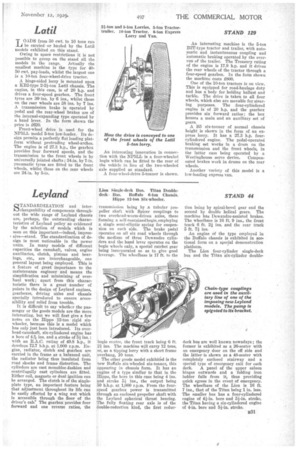Leyland
Page 169

If you've noticed an error in this article please click here to report it so we can fix it.
STANDARDIZATION and interchangeability of components throughout the wide range Of Leyland chassis are, perhaps, the outstanding characteristics of Leyland policy as evidenced by the selection of models which is seen on this important—indeed, impressive—stand. The standardization of design is most noticeable in the power units. In many models of different capacities the camshaft, valves, engine auxiliaries, clutch, pistons and bearings, etc., are interchangeable, one general layout being employed. This is a feature of great importance to the maintenance engineer and means the simplification and minimizing of overhaul work ; apart from this characteristic there is a great number of points in the design of Leyland engines, gearboxes, driving axles and chassis specially introduced to ensure accessibility and relief from trouble.
It is difficult to say 'whether the passenger or the goods models are the more interesting, but we will first give a few notes on the Hippo 12-ton rigid sixwheeler, because this is a model which has only just been introduced. Its overhead-camshaft, six-cylindered engine has a bore of 4-,9-c ins, and a stroke of 5i ins. ; with an ILA.C. rating of 49.8 h.p., it develops 72.7 b.h.p. at 1,000 r.p.m. Engine, radiator, clutch and gearbox are carried in the frame as a balanced unit, the radiator being thus insulated from road shocks and frame distortion. The cylinders are cast monobloc fashion and centrifugally cast cylinders are fitted. Either coil, magneto or dual ignition can be arranged. The clutch is of the singleplate type, an important feature being that adjustment throughout its life can be easily effected by a wing nut which is accessible through the floor of the driver's cab The gearbox provides four forward and one reverse ratios, the
transmission being by ,a tubular propeller shaft with Spicer couplings to two overhead-worm-driven axles, these forming a self-contained bogie, employing a single semi-elliptic spring for suspension on each side. The brake pedal operates on all six road wheels through the medium of three Dewandre cylinders and the hand lever operates on the bogie wheels only, a special ratchet gear being incorporated so as to give good leverage. The wheelbase is 17 ft. to the
bogie centre, the front track being 6 ft 2i ins. The machine will carry 12 tons, or, as a tipping lorry with a short frame overhang, 10 tons. The other goods model exhibited is the new Buffalo six-wheeled six-tonner, this appearing in chassis form. It has an engine of a type similar to that in the Hippo, the bore in this case being 4 ins. and stroke 5i ins., the output being 50 b.h.p. at 1,000 r.p.m. From the four. speed gearbox power is transmitted through an enclosed propeller shaft with the Leyland spherical thrust bearing. The fully floating rear axle is of the double-reduction kind, the first reduc
tion being by spiral-bevel gear and the second by double helical gears. The machine has Dewandre-assisted brakes. The wheelbase is 16 ft 9 ins., the front track 6 ft. 2i ins, and the rear track 5 ft. 7# ins.
An engine of the type employed in the Buffalo chassis is exhibited in sectional form on a special demonstration
platform. '
The Lion four-cylinder single-deck bus and the Titan six-cylinder double
deck bus are well known nowadays ; the former is exhibited as a 26-seater with an emergency door on the off side and the latter is shown as a 48-seater with completely enclosed stairway and a special type of emergency exit for each deck. A panel of the upper saloon hinges outwards and a folding iron ladder falls from it, thus providing quick egress in the event of emergency. The wheelbase of the Lion is 16 ft. 7 ins., that of the Titan being 1 in. less. The smaller bus has a four-cylindered engine of 4i-in, bore and 54-in, stroke, the Titan having a six-cylindered engine of 4-in, bore and 54-in. stroke.








































































































































































































































































































































